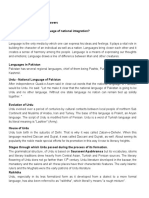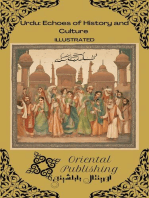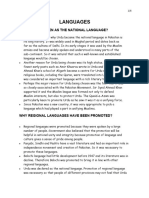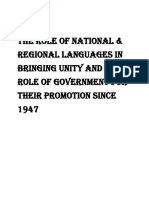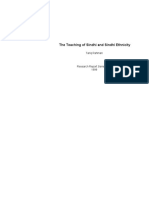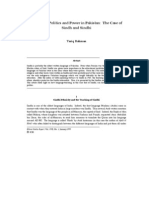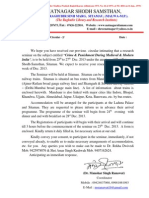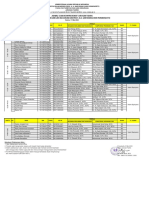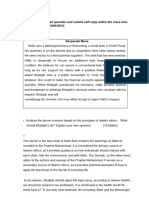Tamil Irshad
Tamil Irshad
Uploaded by
Mushtak MuftiCopyright:
Available Formats
Tamil Irshad
Tamil Irshad
Uploaded by
Mushtak MuftiOriginal Description:
Copyright
Available Formats
Share this document
Did you find this document useful?
Is this content inappropriate?
Copyright:
Available Formats
Tamil Irshad
Tamil Irshad
Uploaded by
Mushtak MuftiCopyright:
Available Formats
Genesis of Urdu language Many theories have been propounded regarding the origin of Urdu language.
These are important research works yet there is ample room for further investigation. In modern times the scholars have adopted a unique way of studying this subject which gives this study a flicker of hope. The fact is that whenever Urdu is mentioned, we visualize a series of alphabets with overwhelmingly number of Arabic and Persian letters and so we begin to link the origin of Urdu with the arrival of Muslims in India. Although it may be right to some extent but this is not the whole truth. There is no doubt that the current script of Urdu is its integral part but if the historical development is observed minutely then Urdu appears to be older than the present script. The origin of Urdu and its development is not a subject for linguistics only. The historical, geographical and cultural factors do play their role as well which are being studied now and, without this study, the history of Urdu will remain incomplete. In fact, to understand Urdus development and evolution, one must go through the Indian geographical and cultural traditions. Among the other countries of the world, India occupies a unique place on its map. Most of its countries carry the convention of one nation, one religion and one language. So all countries functioned as one unit of the same culture and civilization. India, however, is an exception. It has a tradition of accommodating different languages, religions and peoples from olden times. This country has been the home of multi-religious, multi-language, and multi-ethnic groups from the beginning because of its temperament and geographical conditions. The large number of languages created some problems whereby two groups of people living in the same region became strangers to each other; a Rajasthani was unaware of Bhails language and a man from Madhya Pardesh had no knowledge of Kashmiri language. However, because of their requirements, they were bound to interact and communicate with each other; particularly the commercial necessities were of such nature that it was essential to know the other partys language or, at least, convey his own message to others. But naturally it was not easy for a single person to know so many languages. So the authorities, right from the initial stage, encouraged the development of a language which could realize their commercial
objects and become the source of communication in the market and helpful in the mutual trade. This language was urban in its application and nature because the markets were found only in towns. The language enabled a trader from Ajmer to sell his goods in Patna and also purchase from there. It was an urban language which served as a source of interaction and communication between the two groups not knowing each others language. Many dialects of this language emerged which came under the influence of the languages spoken in the surroundings of the towns and, therefore, became distinct to each other. The Rajasthan, Hyderabad, Lucknow and Patna developed their own separate dialects. This language is known by many names in the history, and perhaps the oldest name is Prakirit. It was also known by Shorsaini and Upbharans. In later developments it was called Raikhta, Hindwi, and Hindustani until finally it got the name of Urdu. The experts of linguistics have divided India, particularly the northern India, into three periods according to the evolution and emergence of languages. They are: 1- Old Indo-Aryan period, from 1500 BC to 500 BC 2- Medieval Indo-Aryan period, from 500 BC to 1000 AD 3- Modern Indo-Aryan period, from 1000 AD to date. The last is the Modern Indo-Aryan period and Urdu language with its current script and classical literature belongs to this particular period. In fact the 11th century AD brought an unprecedented political, social and cultural change in the history of India. The rest of the period continued under the impact of this change. Muhammad bin Qasim had conquered Sind in 712 AD. Consequently Sind witnessed many adjustments and changes within the area especially in the field of linguistics. The Sindi language drew closer to Arabic and because Sind had direct relations with other parts like Rajasthan and Punjab, its linguistic changes also affected the said areas. Mahmud Ghaznavi occupied a considerable portion of northern India around 1000 AD. He extended his empire as far as Lahore which gave way to a new linguistic experiment in Punjab. After the establishment of Sultanate in Delhi in
12th century, the process of the experiment got extended, and the other spoken dialects of northern India like kharhi boli, Rajasthani, Punjabi, Gujrati, Magadhi, Mewati, Nabdili, Brijbhasha etc. were penetrated by an unfelt yet formidable element of conformity and sameness. At the time of their transformation into writing, the Persian script was used with few variations. So, now this linguistic consistency became more strengthened and all major towns in northern and southern India become connected to each other through this new language and fresh script. And this, actually, is the Urdu language. As stated earlier, the linguistic scholars presented many theories about the origin of Urdu. The difference in theories seems to have a geographical phenomenon. It is interesting to note that every researcher thought that Urdu originated from his own region. For example Hafiz Mahmud Shirani carried out his research work in Punjab and he concluded that Urdu is a developed form of Punjabi. Dr. Muhyiuddin Qadri Zor authored his book in Deccan and concluded that Urdu is originated from Dakhani language. Likewise Maulana Muhammad Husain Azad who lived in Delhi and Agra felt that Brijbhasha is transformed into Urdu. Professor Masud Husain Khan reflected that Urdu actually is made of the four languages spoken in the suburbs of Delhi, namely kharhi boli, Brijbhasha, Mewati and Haryanwi. But there are many dimensions yet to be touched in this field. It should also be noted that all researchers of the theory of Urdus origin were either historians or literary figures and even though they admired the language, but lacked the linguistic expertise. Consequently a weak aspect of their findings was that they did not analyze the temperament and character of Urdu in the light of the study of local languages. They observed that in Brijbhasha a verb ends with T and in Urdu with A, so theyjoined it with Brij bhasha.The same thing happened with other languages especially the kharhi boli. Even a great scholar like Syed Sulaiman Nadvi, believing that the linguistic change was purely under the influence of cultural study, linked the origin of Urdu with the arrival of Muslims in Sind. There is no doubt that the present form of Urdu language is associated with the coming of Muslims to India and, that is why, all historians of Urdu literature connect the beginning of Urdu language with the appearance of
Muslims on the sub-continent. The fact is that Urdu language is a blend of Muslim culture and languages with the Indian culture and its languages. Different opinions about the origin of Urdu language Undoubtedly, Urdu language can be cited as the meeting point of two different cultures hitherto alien to each other. The experts differ about its original place and the circumstances that brought it into being. In this modern age of research and investigation the controversy among the scholars persists. That not withstanding, a conclusion can be reached looking at the investigation and analysis done by the scholars. There is a long list of researchers, from Mir Amman to Jameel Jalbi, who have tried to ascertain Urdus origin in their own way. Among them Muhammad Husain Azad, Syed Sulaiman Nadvi, Naseeruddin Hashmi, Hafiz Mahmud Shirani, Akhtar Orinawi, Muhyiddin Qadri Zor, Dr. Shaukat Sabzwari and Dr. Masud Husain Khans views deserve our attention. Muhammad Husain Azad declared Brijbhasha as the original source of Urdu whereas Syed Sulaiman Nadvi thinks that it formally commenced with Muhammad bin Qasims invasion on Sind. Hashmi looks for it in the rocky terrain of Deccan and Shirani crosses the green pastures of Punjab, and according to Sabzwari it is an improved form of kharhi boli or Hindustni. Dr. Masud Husain Khan differs from Shirani and opines that the language which Muslims brought from Punjab to Delhi was amalgamated in the kharhi boli spoken in the surroundings of Delhi, and then the mixture of Haryanwi and kharhi boli became the very first impression of Urdu. Away from the above opinions, Akhtar Orinawi thinks that Urdu was not born in a specified geographical region or in an identified period of history. According to him its growth took place in different historical phases and in different geographical settings of India under the influence of different regional languages, and at a particular time it became the language of the whole country. Dr. shaukat Sabzwari suggests that Urdu was born much before the coming of Muslims to India. He says: Urdu or Hindustani is derived from that form of Upbharansh which was being used in Madhya Pardesh in the beginning of eleventh century AD. Or it can also be said that Urdus present form is a developed variety of old north-western India. Dr. Sabzwaris suggestion
has got weight but he contradicts it in many other places. He therefore does not reach a decisive point himself and confuses the reader as well. According to Syed Sulaiman Nadvi the arrival of Arabs to Sind gave way to intermingling of words which was responsible for the initial structure of Urdu. This theory is not accepted on the ground that the languages are formed on the bases of verb and pronouns. If not so many world languages of today might have lost their existence under the influence of English. Despite his well intended effort Dr. Akhtar Orinawi also treaded the same course. Naseeruddin Hashmis submission that Urdu was born in Deccan is a gross misunderstanding. The Muslims, on their arrival to Deccan, met Dravidian people and lived with them. The birth of Urdu out of out of their intimacy can only be a fantasy. Dr. Masud Husain Khan and Dr. Shirani begin their journey together on identical lines but part each other near the destination. Shirani says that when Arab Muslims came to Delhi in 1192 AD., they brought Punjabi with them which later developed into Urdu. Dr. Khan disagrees with this theory and says that the language brought by Arab Muslims gradually suffocated in the Delhi environment. The language of Muslims was overwhelmed by Haryanwi and kharhi boli. These languages, alongwith the interaction of the people, continued to progress and resulted in the birth of Urdu. In this connection, Dr. Gyan Chands statement can be taken as correct to large extent. He states: The origin of Urdu should be investigated into two phases. First is the beginning of kharhi boli and the second is the inclusion of Arabic and Persian into kharhi boli which is named Urdu. From Mir Amman to Dr. Masud Husain Khan talked about the second phase whereas Dr. Shaukat Sabzwari and Dr. Suhail Bukhari emphasized on the first phase. In the light of above opinions presented by the scholars, we can conclude that all linguistic experts agree that Urdu was born in northern India and from here it travelled to the South. Dr. Khans statement that even today Urdu is the language of the plains of Ganges and Yamuna carries a lot of weight because, like trees and plants, the roots of languages also go deep into the soil. However, we still have to go a long way and look for new openings in our search for Urdus origin.
You might also like
- A Short History of The Urdu LanguageDocument4 pagesA Short History of The Urdu LanguageAfrasiyab Khan100% (1)
- Read and Speak Arabic PDFDocument108 pagesRead and Speak Arabic PDFnadinedana100% (1)
- The Global Filipino - Final (12 Files Merged) PDFDocument219 pagesThe Global Filipino - Final (12 Files Merged) PDFJan Carla Cabusas Curimatmat100% (2)
- Dua Noor - FullDocument15 pagesDua Noor - FullBalal Jabbar67% (12)
- Whoselanguageisurdu MqureshiDocument11 pagesWhoselanguageisurdu Mqureshiapi-348334687100% (1)
- Urdu As The National Language of PakistanDocument8 pagesUrdu As The National Language of PakistanMary QuinnNo ratings yet
- History of HindiDocument5 pagesHistory of HindiGaurav ChauhanNo ratings yet
- Pak Studies Chapter 7Document16 pagesPak Studies Chapter 7kashif0% (1)
- The Origin of Urdu and Suhail Bukhari's Linguistic Theories: Job Vacancies DubaiDocument3 pagesThe Origin of Urdu and Suhail Bukhari's Linguistic Theories: Job Vacancies DubaiFakhir MarghoobNo ratings yet
- Artical-4 v16 1Document33 pagesArtical-4 v16 1رضا محمد رضاNo ratings yet
- Artical-4 v16 1 PDFDocument33 pagesArtical-4 v16 1 PDFرضا محمد رضاNo ratings yet
- LL - Review of Research PapersDocument12 pagesLL - Review of Research PapersAdishree KrishnanNo ratings yet
- What Do You Understand by Linguistic Plurality? Discuss With References To Bhakti and Sufi TraditionsDocument3 pagesWhat Do You Understand by Linguistic Plurality? Discuss With References To Bhakti and Sufi TraditionsChidambara AgrawalNo ratings yet
- Urdu Christopher LeeDocument15 pagesUrdu Christopher LeesamarqandiNo ratings yet
- Urdu Origins (Print It)Document6 pagesUrdu Origins (Print It)Ritvik Singh SabharwalNo ratings yet
- María Isabel Maldonado García: The Urdu Language ReformsDocument22 pagesMaría Isabel Maldonado García: The Urdu Language ReformsVipin KrishnaNo ratings yet
- Modernism in Hindi and Urdu PoetryDocument18 pagesModernism in Hindi and Urdu PoetryAbdurRehmanKhànNo ratings yet
- LANGUAGESDocument7 pagesLANGUAGESMuqeet KhanNo ratings yet
- Chap. 5 HistoryDocument8 pagesChap. 5 HistorymuhNo ratings yet
- The Great Indian Languages DivisionDocument16 pagesThe Great Indian Languages DivisionSushree MAENG20No ratings yet
- Language Politics - Hindi and UrduDocument6 pagesLanguage Politics - Hindi and UrduheretostudyNo ratings yet
- Literature Review Meaning in UrduDocument4 pagesLiterature Review Meaning in Urduafmzrvaxhdzxjs100% (1)
- Sir Usman HameedDocument7 pagesSir Usman HameedFaiq HassanNo ratings yet
- Ijires 154 FinalDocument5 pagesIjires 154 FinalYaseen ShahNo ratings yet
- PST Assignment Sejal Sitani 1912285Document6 pagesPST Assignment Sejal Sitani 1912285Sejal SitaniNo ratings yet
- 11 Sohail Sahab 29 1Document11 pages11 Sohail Sahab 29 1merajaeonNo ratings yet
- Topic: 8: Urdu Is The National Language of Pakistan Since 1947. The Main Differences BetweenDocument7 pagesTopic: 8: Urdu Is The National Language of Pakistan Since 1947. The Main Differences BetweenAurangzaib Sarfraz HussainNo ratings yet
- The Impact of Persian Language On Indian Languages: Ali Akbar KhansirDocument6 pagesThe Impact of Persian Language On Indian Languages: Ali Akbar KhansiryaqubaliyevafidanNo ratings yet
- My Name Is Urdu and I Am Not A Muslim - Rana SafviDocument14 pagesMy Name Is Urdu and I Am Not A Muslim - Rana Safvitvphile1314No ratings yet
- LanguagesDocument7 pagesLanguagesAhmad RazaNo ratings yet
- 5 LanguagesDocument6 pages5 LanguagesLaiba MasoodNo ratings yet
- Pollock - Literary Cultures in History. Reconstructions From South Asia (UCP) - 1Document111 pagesPollock - Literary Cultures in History. Reconstructions From South Asia (UCP) - 1Shyanjali Datta100% (1)
- 1st PUBLICATION Sajad OPJS UNIVERSITY English Translation (URDU)Document5 pages1st PUBLICATION Sajad OPJS UNIVERSITY English Translation (URDU)Ishfaq Ahmad MirNo ratings yet
- The Divide of Hindi and UrduDocument5 pagesThe Divide of Hindi and UrduSagar KumarNo ratings yet
- How To Do Multilingual HistoryDocument22 pagesHow To Do Multilingual Historyhamad abdullahNo ratings yet
- Dogri LanguageDocument19 pagesDogri LanguageVinamra Gupta100% (1)
- The Role of Persian Language Before Independence in India: Dr. Mirza Mohd Ejaz AbbasDocument4 pagesThe Role of Persian Language Before Independence in India: Dr. Mirza Mohd Ejaz AbbasMohammad MiyanNo ratings yet
- Tariq Rehman Urdu Indian MuslimsDocument4 pagesTariq Rehman Urdu Indian MuslimsShubham Swastik BeheraNo ratings yet
- Languages of PakistanDocument16 pagesLanguages of PakistanAtyab AliNo ratings yet
- Nehru and Language PoliticsDocument21 pagesNehru and Language PoliticsSurbhi100% (1)
- Linguistics History of IndiaDocument28 pagesLinguistics History of IndiaChandranshu Garg100% (1)
- Languages of Pakistan: Hindī, " (Language) of India" Dehlavi "OfDocument5 pagesLanguages of Pakistan: Hindī, " (Language) of India" Dehlavi "OfSarmad ShafiqueNo ratings yet
- IJCRT1133405Document4 pagesIJCRT1133405Romio RobinNo ratings yet
- The Hindi-Urdu Controvercy of The North-Western ProvincesDocument11 pagesThe Hindi-Urdu Controvercy of The North-Western ProvincesRahulNo ratings yet
- Sindhi Language and Litrature A Brief AccountDocument78 pagesSindhi Language and Litrature A Brief AccountNaeem Ahmed UmraniNo ratings yet
- The Teaching of Sindhi Language by Tariq RehmanDocument19 pagesThe Teaching of Sindhi Language by Tariq RehmanZarqa SahitoNo ratings yet
- Safia Siddiqui Kanza Javaid Nazia Suleman MinDocument16 pagesSafia Siddiqui Kanza Javaid Nazia Suleman MinShahid Iltaf QureshiNo ratings yet
- Bhatt Hindi LanguageDocument13 pagesBhatt Hindi Languagearsalanoffical99No ratings yet
- Urdu Literature TrendsDocument5 pagesUrdu Literature TrendsAbu Talha Farooqi100% (1)
- Sindhi Language and Its HistoryDocument5 pagesSindhi Language and Its HistoryAsiaNo ratings yet
- Unit III Edited123Document25 pagesUnit III Edited123Vansh YadavNo ratings yet
- Rekhta Poetry in Mixed LanguageDocument64 pagesRekhta Poetry in Mixed LanguageAshutoshNo ratings yet
- History Chap 5Document6 pagesHistory Chap 5ayan031077No ratings yet
- Hindi, HinglishHead To HeadDocument8 pagesHindi, HinglishHead To HeadAbhishek Gautam100% (1)
- Evolution of Odia LanguageDocument4 pagesEvolution of Odia LanguageSatyavikash BhuyanNo ratings yet
- Ch-5-Languages of PakistanDocument14 pagesCh-5-Languages of Pakistansadia.klassonNo ratings yet
- Unit 14Document16 pagesUnit 14Vinay KumarNo ratings yet
- Thesis On Urdu LiteratureDocument4 pagesThesis On Urdu LiteratureBuyResumePaperCanada100% (2)
- Chapter 5: Urdu and Regional Languages Urdu LanguageDocument10 pagesChapter 5: Urdu and Regional Languages Urdu LanguageAdnan Qureshi100% (1)
- Language, Power and Politics in PakistanDocument14 pagesLanguage, Power and Politics in PakistansajjadmirNo ratings yet
- Mini Hindi Dictionary: Hindi-English / English-HindiFrom EverandMini Hindi Dictionary: Hindi-English / English-HindiRating: 1 out of 5 stars1/5 (1)
- The Love That Did Not Fail: InterviewDocument4 pagesThe Love That Did Not Fail: InterviewMushtak MuftiNo ratings yet
- Sessssminar 2013, IInd CircularDocument2 pagesSessssminar 2013, IInd CircularMushtak MuftiNo ratings yet
- Nahdlatul UlamaDocument1 pageNahdlatul UlamaMushtak MuftiNo ratings yet
- IONA BriefIntroductionDocument0 pagesIONA BriefIntroductionMushtak MuftiNo ratings yet
- Moroccan Arabic Textbook 19Document6 pagesMoroccan Arabic Textbook 19Mushtak MuftiNo ratings yet
- Msa Appointments 1h Ab3Document3 pagesMsa Appointments 1h Ab3Mushtak MuftiNo ratings yet
- Moroccan Arabic Textbook 23Document2 pagesMoroccan Arabic Textbook 23Mushtak MuftiNo ratings yet
- Moroccan Arabic Textbook 26Document1 pageMoroccan Arabic Textbook 26Mushtak MuftiNo ratings yet
- Proposal For The Translation ofDocument7 pagesProposal For The Translation ofMushtak MuftiNo ratings yet
- Moroccan Arabic Textbook 21Document14 pagesMoroccan Arabic Textbook 21Mushtak MuftiNo ratings yet
- Jadwal Kompre Tadris MeiDocument2 pagesJadwal Kompre Tadris MeiNurul AmaliaNo ratings yet
- A-Islamic Studies: Cave Hira Is in The - MountainDocument3 pagesA-Islamic Studies: Cave Hira Is in The - MountainSaqib AltafNo ratings yet
- iSLAMIC LAW Marriage QuestionDocument3 pagesiSLAMIC LAW Marriage QuestionSayed Adnan ShahNo ratings yet
- 1 Infertility and The Purposes of Marriage in Legal TheoryDocument31 pages1 Infertility and The Purposes of Marriage in Legal TheoryLuca ManobanNo ratings yet
- 035 Surat Pengantar Proposal Pelindo IIIDocument1 page035 Surat Pengantar Proposal Pelindo IIIdian puspitasariNo ratings yet
- 'Uhb 2020.12.03.2. Pas1 20 - 21. Xii Agama Islam (Jawaban) - Form Responses 1Document7 pages'Uhb 2020.12.03.2. Pas1 20 - 21. Xii Agama Islam (Jawaban) - Form Responses 1Aydinaraffa TsNo ratings yet
- THESIS EDIAnalysis of The Differences in Translation of The First Twenty Verses of Surat Al Kahfi by Marmaduke Pickthall, Muhammad Taqiud Din Al Hilali and Muhammad Muhsin Khan and Sam GerransT 1Document25 pagesTHESIS EDIAnalysis of The Differences in Translation of The First Twenty Verses of Surat Al Kahfi by Marmaduke Pickthall, Muhammad Taqiud Din Al Hilali and Muhammad Muhsin Khan and Sam GerransT 1Muhamad AriefNo ratings yet
- تأثير مبادىء الشريعة الاسلامية على قواعد القانون المدني في مجال العقدDocument18 pagesتأثير مبادىء الشريعة الاسلامية على قواعد القانون المدني في مجال العقدnouaribaraa3No ratings yet
- Danube Bulgaria and Khazaria As Parts ofDocument24 pagesDanube Bulgaria and Khazaria As Parts ofmilan crnjakNo ratings yet
- Hafs and Warsh (Part 2)Document4 pagesHafs and Warsh (Part 2)Asad HoseinyNo ratings yet
- أسرار الحروف وحساب الجمل عرض ونقد رسالة ماجستير تأليف طارق بن سعيد القحطانيDocument364 pagesأسرار الحروف وحساب الجمل عرض ونقد رسالة ماجستير تأليف طارق بن سعيد القحطانيReo BetaNo ratings yet
- 6 Gift-1-1Document8 pages6 Gift-1-1amit HCSNo ratings yet
- صحیح مسلم جلد ۱ اردوDocument823 pagesصحیح مسلم جلد ۱ اردوnaqvi202No ratings yet
- Quiz Chapter 1 - Be - Case StudyDocument2 pagesQuiz Chapter 1 - Be - Case Studydhr12210014100% (1)
- Spiritreports Blogspot Com 2019 02 Isa El Buba 2 HTMLDocument36 pagesSpiritreports Blogspot Com 2019 02 Isa El Buba 2 HTMLDaniel EspinosaNo ratings yet
- Sf1 - 2023 - Grade 3 - TopazDocument7 pagesSf1 - 2023 - Grade 3 - Topazvillardejaneanne92No ratings yet
- Jadwal Kelas Periode 25 Agustus 2018Document45 pagesJadwal Kelas Periode 25 Agustus 2018Deby LasimparaNo ratings yet
- ReadDocument9 pagesReadSWALAH DH PRINTNo ratings yet
- The Battle of Ahzaab WorksheetDocument2 pagesThe Battle of Ahzaab Worksheetlifephoenix755No ratings yet
- Islam, Feminism, and Islamic Feminism: Between Inadequacy and InevitabilityDocument23 pagesIslam, Feminism, and Islamic Feminism: Between Inadequacy and InevitabilityPilar EspitiaNo ratings yet
- News Letter 2021Document16 pagesNews Letter 2021tisuchiNo ratings yet
- Ajaib-ul-Quran by - Shaikh Al Hadees Hazrat Alama Abdul Mustafa SahabAzmiDocument358 pagesAjaib-ul-Quran by - Shaikh Al Hadees Hazrat Alama Abdul Mustafa SahabAzmiMarfat Library100% (2)
- Nalar: Jurnal Peradaban Dan Pemikiran Islam: Niswah QonitahDocument10 pagesNalar: Jurnal Peradaban Dan Pemikiran Islam: Niswah Qonitahsholeh bankNo ratings yet
- Pemikiran Muhammad Rasyid Ridho Tentang F7c25e26Document19 pagesPemikiran Muhammad Rasyid Ridho Tentang F7c25e26Misbahul MunirNo ratings yet
- Master ABSENSI PKBM IQRODocument232 pagesMaster ABSENSI PKBM IQROAbdul KodirNo ratings yet
- Chapter 6-Contracting PartiesDocument49 pagesChapter 6-Contracting PartiesNUR AISYAH NABILA RASHIMYNo ratings yet
- Johor HisstoryDocument2 pagesJohor HisstoryjossielangkaitNo ratings yet
- The Life of Prophet Muhammad SAWDocument5 pagesThe Life of Prophet Muhammad SAWkalaNo ratings yet







